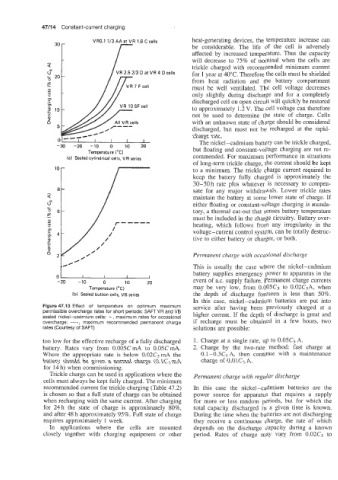Page 481 - Battery Reference Book
P. 481
47/14 Constant-current charging
VRO.l 1/3 AA at VR 1.8 C cells heat-generating devices, the temperature increase can
be considerable. The life of the cell is adversely
affected by increased temperature. Thus the capacity
will decrease to 75% of nominal when the cells are
trickle charged with recommended minimum current
20 - VR 2.5 2/3 D at VR 4 D cells for 1 year at 40°C. Therefore the cells must be shielded
from heat radiation and the battery compartment
must be well ventilated. The cell voltage decreases
only slightly during discharge and for a completely
discharged cell on open circuit will quicMy be restored
to approximately 1.2 V. The cell voltage can therefore
not be used to determine the state of charge. Cells
with an unknown state of charge should be considered
discharged, but must not be recharged at the rapid-
charge rate.
The nickel-cadmium battery can be trickle charged,
-30 -20 -10 0 10 20 but floating and constant-voltage charging are not re-
Temperature ("C)
(a) Sealed cylindrical cells, VR series commended. For maximum performance in situations
of long-term trickle charge, the current should be kept
to a minimum. The trickle charge current required to
keep the battery fully charged is approximately the
30-50 h rate plus whatever is necessary to compen-
sate for any major withdrawals. Lower trickle rates
maintain the battery at some lower state of charge. If
either floating or constant-voltage charging is manda-
tory, a thermal cut-out that senses battery temperature
must be included in the charge circuitry. Battery over-
heating, which follows from any irregularity in the
voltage-current control system, can be totally destruc-
tive to either battery or charger, or both.
Permanent charge with occasional discharge
This is usually the case where the nickel-cadmium
battery supplies emergency power to apparatus in the
01 I I I 1 event of a.c. supply failure. Permanent charge currents
-20 -10 0 10 20
Temperature ("C) may be very low, from 0.005C~ to 0.02C5A, when
Ib) Sealed button cells, VB series the depth of discharge foreseen is less than 50%.
In this case, nickel-cadmium batteries are put into
Figure 47.13 Effect of temperature on optimum maximum service after having been previously charged at a
permissible overcharge rates for short periods: SAFT VR and VB higher current. If the depth of discharge is great and
sealed nickel-cadmium cells: - , maximum rates for occasional
overcharge: ---- , maximum recommended permanent charge if recharge must be obtained in a few hours, two
rates (Courtesy of SAFT) solutions are possible:
too low for the effective recharge of a fully discharged 1. Charge at a single rate, up to 0.05C5 A.
battery. Rates vary from 0.005CmA to 0.05CmA. 2. Charge by the two-rate method: fast charge at
Where the appropriate rate is below 0.02C5mA the 0.1-0.3C~ A, then continue with a maintenance
battery should be given a normal charge (0.1C5 mA charge of 0.01Cs A.
for 14 h) when commissioning.
Trickle charge can be used in applications where the Permanent charge with regular discharge
cells must always be kept fully charged. The minimum
recommended current for trickle charging (Table 47.2) In this case the nickel-cadmium batteries are the
is chosen so that a full state of charge can be obtained power source for apparatus that requires a supply
when recharging with the same current. After charging for more or less random periods, but for which the
for 24h the state of charge is approximately SO%, total capacity discharged in a given time is known.
and after 48 h approximately 95%. Full state of charge During the time when the batteries are not discharging
requires approximately 1 week. they receive a continuous charge, the rate of which
In applications where the cells are mounted depends on the discharge capacity during a known
closely together with charging equipment or other period. Rates of charge may vary from 0.02Cs to

